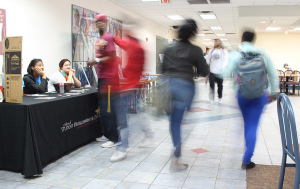
SPRING ENROLLMENT
Official reports confirmed Feb. 10 that enrollment increased by approximately 3 percent, the fourth consecutive semester of increases.
Keith Lamb, vice president of student affairs and enrollment management, estimated this 3 percent increase. Although numbers increased from 5,574 students in spring 2015 to 5,736 students in spring 2016 (2.91 percent), numbers showed a decrease from 6,043 students in fall 2015 to 5,736 students in spring 2016.
“At a traditional campus such as ours,” Lamb said, “spring enrollment is always lower than fall enrollment, as the large influx of new students occurs for the fall semester.”
CHANGE OVER TIME
Provost and Vice President of Academic Affairs Betty Stewart explained that there were a number of years where the freshmen enrolling class was smaller. Those students still have to work through their four or five years at the university, so as the smaller classes progress toward graduation, they are backfilling by increasing the freshmen class at the beginning of the semester.
“For example, if we had a small class in 2012 and now they’re in their fourth year in 2016, they’ve worked through the system and every year they’ve been in the system, we’ve had a lower enrollment,” Stewart said. “But let’s say in 2012 we now have a larger class, they still have to work through the system. We’re having a combination of large and small [classes], so that means our net enrollment is no longer decreasing but increasing.”
SEMESTER CREDIT PRODUCTION
Along with enrollment numbers increasing, semester credit hour production has increased by 4.37 percent compared to last semester. Stewart said if a student wants to graduate in four years, they need to take an average of 15 hours per semester.
As students take more semester credit hours, that number is reported to the coordinating board and is used to determine university funding that comes from the state. The higher the semester credit hours, the higher the funding.
“Those dollars can be used for the needs of the university whether it’s faculty and staff salaries, instructional materials, or technology,” Stewart said. “It just depends on the needs of the university how those dollars are distributed. All of them are to be used to help us educate our students.”
WHY ARE NUMBERS CHANGING
The majority of students that come to MSU are from the Dallas and Ft. Worth area. This year, students from Dallas-Fort Worth counted for 35 percent of enrollment. Another 28 percent came from Wichita County and 10 percent came from 56 international countries.
Lamb said some of the biggest competitors for students are from the University of North Texas, Texas Tech University, University of Texas at Arlington, Tarleton State University and Texas State University at San Marcos. Although there is competition among said universities, Lamb said he believes enrollment will continue to rise based on the increasing numbers over recent years.
“We’re just trying to get people to tour here because once they are here, we do a good job of converting them,” Lamb said. “We have a great campus and we have a great faculty and staff that when they talk to prospective students, they can fill that interest.”
















